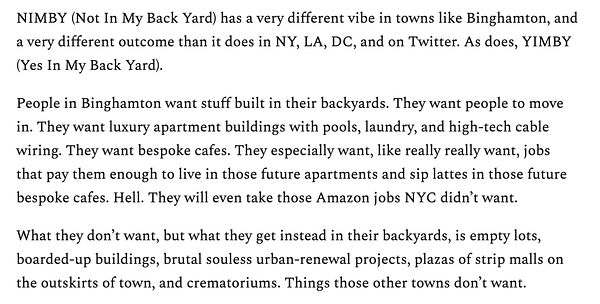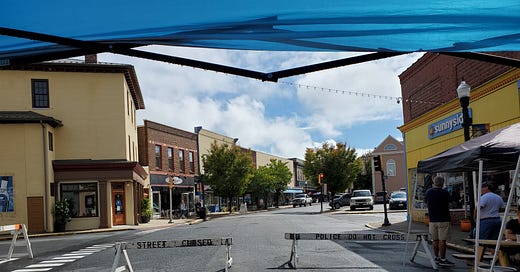The Rest of the Country
Urbanism is a way of seeing places in general as well as advocacy for specific places
Jason Segedy, a Rust Belt urbanist in Akron, Ohio, wrote this recently:

I agree with this, despite so much of my commentary focusing on the D.C. area. That isn’t because I think it’s the only place in the country worth living in, it’s just that, well, I actually do live here! And despite the narrative that it’s transient and placeless, I find it to be an incredibly interesting place that very much has its own character and charm.
I put Segedy’s point in my own words:

I did a post about this back in November, fittingly headlined “How Many Places Are Worth Living In?” I wonder if NIMBY types don’t sometimes have a little bit of a point that the issue—at least in this small handful of prestige cities—isn’t too little supply but too much demand. Or to put it a different way, that what we call the housing crisis is not a purely economic issue, but in part a cultural one: a result of the idea that most of America is not good enough.
Now, my own view is “why not both?” I do think it’s shortsighted and snobbish to write off the vast majority of the country. But I don’t think this means there’s no housing problem in popular, growing, expensive cities. In fact, I suggested that in my recent piece on Millennials and homeownership:
Sometimes these conversations go in the direction of “move to an affordable city.” That may be a solution for some people, depending on their education and professional backgrounds and regional job markets. But it doesn’t really solve the fundamental social problem: housing markets are not allowed to keep up with job markets in popular and growing metro areas.
I suspect most urbanists who focus on the high-growth, high-cost cities do so for the same reason I do: they live in those places. What we could use, however, is more Rust Belt urbanists, and also folks doing this kind of work in the more car-oriented Sunbelt cities, that many Northeasterners think of as not real cities at all. And to pay more attention to the people who are already doing this work in those places. As my sub-headline says, urbanism is a way of seeing places in general. I try to never write off a place in my mind, and remember that everywhere that people live is home, and everything that goes with that.
I think, for example, of people out here, who might look at a place like the St. Louis metropolitan area, with almost three million, and wonder, “what do all those people do? What’s there?” Well, three million people are there, for one. You see this with attitudes about choosing where to live. You see it with travel, too. People pay huge sums to visit expensive, desirable destinations, when there are so many more ordinary but really interesting places out there. It’s almost like passively outsourcing the work of having a good time to your surroundings, instead of engaging with those surroundings. We treat great places like they’re things you sit back and consume, rather than things you work with and help build.
This is all kind of in line with the work Chris Arnade is doing, in places that mostly fall into the category of “not talked about a lot in urbanist discourse.” For example:


He’s a great read, as is Segedy, or Pete Saunders, or Joseph Molnar. Let me know who I’m missing, too!
Related Reading:
Please consider upgrading to a paid subscription to help support this newsletter. You’ll get a weekend subscribers-only post, plus full access to the archive of over 200 posts and growing. And you’ll help ensure more material like this!



